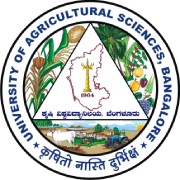Research in Progress
Crop Improvement
1) RILs/inbred lines with resistance to multiple diseases in maize were identified from Approximately 1400 RILs developed from seven 8-way crosses, which are further multiplied for phenotyping and genotyping purposes
2) Thirteen microsatellites from bread fruit was used to screen the fourty eight germplasm accessions of jack fruit including wild species and the Kerala samples Ayoor jack and J. Pathamattam,
showed less genetic diversity
3) The Gus gene was successfully transferred into papaya by a novel chemical-mediated transformation protocol (which is under patent). This will be very useful in developing transgenic as well as CRISPR Cas mediated gene-edited papaya mainly against the devastating Papaya Ring Spot Virus (PRSV).
4) Transcriptome sequencing of Tamarind cv. GKVK-17 through a new paradigm RNA-sequencing has helped in sampling of transcripts in higher proportion than any other techniques. Differential rate of expression of genes in different tissues viz., leaf, flower and fruit were observed. Tartaric acid (TA) responsible for acidic taste occurs in both free and combined form.
Cropping Plan
Crop Production
1) Standardized Precipitation Evapotranspiration Index estimated based on RCP (Representative Concentration Pathways) 4.5 and 8.5 scenarios described by the Intergovernmental Panel on
Climate Change, indicated an increased tendency of drought susceptibility in Chikkaballapur, Chitradurga, Davanagere and Chamarajanagar districts over the near future (2040-2069)
and end century (2070-2099)
2) The university has developed the mobile application “Dhartimitra” and the website www.dhartimitra.uasbangalore.edu.in for getting soil health reports and fertilizer recommendations through soil test crop response approach through survey numbers and geo-coordinates of the field in 10 southern districts. It was released for public use in November 2023 and to date more than 500 beneficiaries have downloaded the app.
3) AICRP on STCR center has developed 65 soil test crop response targeted yield equations for different crops. Fertilizer recommendations through STCR approach enhance yield to an extent of 6-20% among cereals, 10-18% in millets, 8-12% in pulses, 10-12% among oilseeds, and 15-20% in vegetable crops compared to package of practice. Similarly, the use efficiency of nitrogen, phosphorous, and potassium has increased to an extent of 25-30%, 20-25% and 30-45%, respectively.
4) Under “National Innovations on Climate Resilient Agriculture Project”, better crop performance was observed in 45 beneficiary farmers’ fields at Kambadakallu village, Magadi, Tumakuru in an area of 20 hectares with the adoption of dryland technologies like real-time contingent cropping, in-situ and ex-situ moisture conservation, energy management and alternate land use system have been demonstrated with farmers participation.
5) Tree Arboretum is established by planting with 10 different species like Gulmavu, Democarpus, Bael, Aglaya, Amla, Sandal, Thare, Soapnut and popular Bamboo species like Balcova, Tulda
and Asper species during 2023 to maintain different tree species for demonstration to the farming community and to elucidate their information on growth to assess its performance under the agroforestry system.
Cropping Plan
Crop Protection
1) A total of 49 DNA sequences belonging to twenty-seven species of plant-associated mites were submitted to the NCBI – GenBank database during the year
2) Developed species distribution map of 10 white grub species in Karnataka
3) Mass produced and supplied the nucleus culture of native fungal bioagent, Beauveria brongniartii (UASBBb16 Isolate) to other AINP-SAP centres to test against major white
grubs species
4) Survey on the occurrence of areca perianth mite revealed that its infestation on the crop was hitherto restricted to the Chitradurga areca growing areas, is slowly now spreading to the
adjacent taluks of Tumakuru, Shivamogga, Chikkamagaluru and Davanagere districts
Food and Nutrition: AICRP on Women in Agriculture formed one Women Farmer Producer Organisation (WFPO) at Bodaguru village, Shidlaghatta taluk, Chikkaballapura District. Promoted
millet cultivation and its processing and value addition under “Sri Anna Yojane” in Kothakote and Nallagondaiyyagarapalli villages of Bagepalli taluk, Chikkaballapura District. The center has
established 37 Nutrition gardens at Bodaguru village under the “Nutrition Smart Village Programme”.
Center of Excellence on Agricultural Drones and Robotics: During the year, the University’s Centre of Excellence in collaboration with Centres of Innovation & Development in Smart Agriculture
has initiated multi-location trials on the development of standard operating procedures to be in-cooperated in a Package of Practices on the application of chemicals, micronutrients and growth promoters using drones in Finger Millet and Pigeon pea Crop.
Watershed Development to Prevent Drought Program (WDPD) : Various thematic maps like soil map, fertility maps and site-crop suitability maps was generated for 258 Micro Watersheds and
uploaded to the Land Resource Inventory portal. This information will be used by line departments for better land use planning. 258 MWS Atlas (English & Kannada) and 46 SWS Reports were submitted to the respective Joint Director of Agriculture.
Rejuvenating Watersheds for Agricultural Resilience through Innovative Development (REWARD) Project: Various thematic maps like soil map, fertility maps and site-crop suitability
maps were generated for 59 MWS and uploaded in Land Resource Inventory portal. About 24,636 Land resource Inventory cards (LRI Card) were generated for each survey numbers which contains
both physical and chemical properties.





